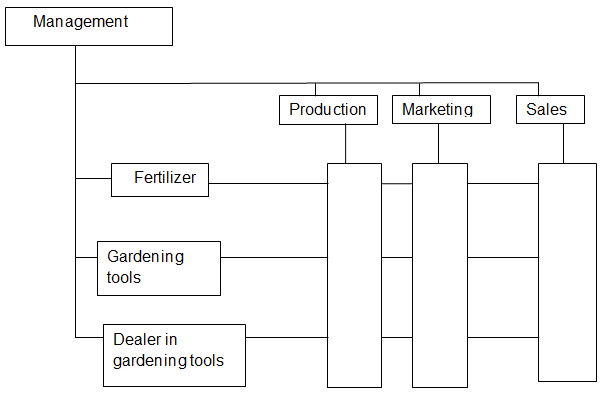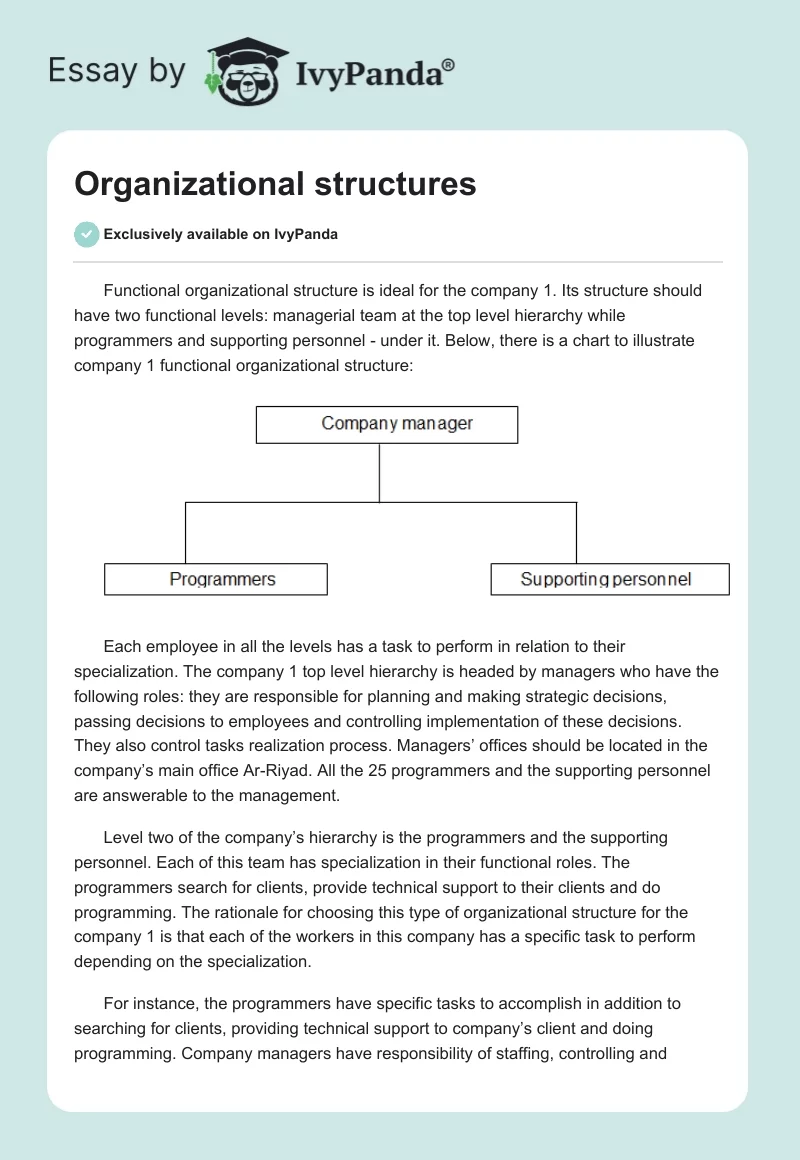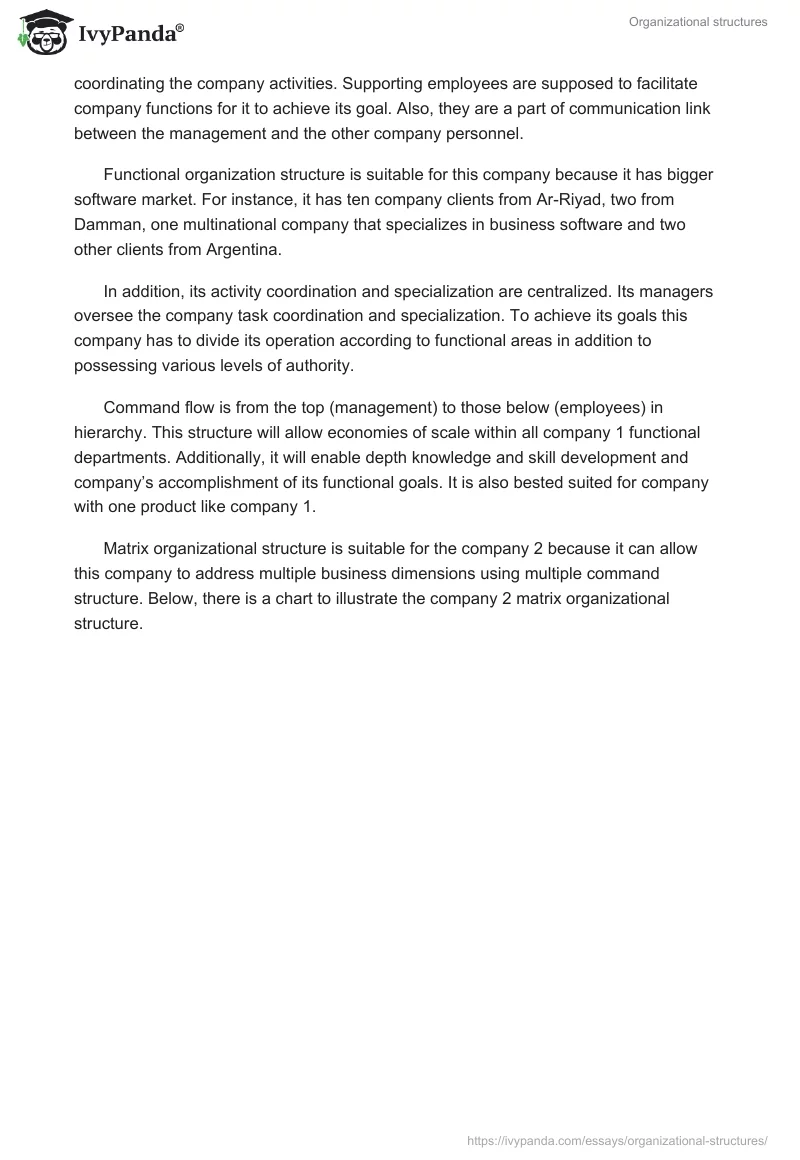Functional organizational structure is ideal for the company 1. Its structure should have two functional levels: managerial team at the top level hierarchy while programmers and supporting personnel – under it. Below, there is a chart to illustrate company 1 functional organizational structure:

Each employee in all the levels has a task to perform in relation to their specialization. The company 1 top level hierarchy is headed by managers who have the following roles: they are responsible for planning and making strategic decisions, passing decisions to employees and controlling implementation of these decisions. They also control tasks realization process. Managers’ offices should be located in the company’s main office Ar-Riyad. All the 25 programmers and the supporting personnel are answerable to the management.
Level two of the company’s hierarchy is the programmers and the supporting personnel. Each of this team has specialization in their functional roles. The programmers search for clients, provide technical support to their clients and do programming. The rationale for choosing this type of organizational structure for the company 1 is that each of the workers in this company has a specific task to perform depending on the specialization.
For instance, the programmers have specific tasks to accomplish in addition to searching for clients, providing technical support to company’s client and doing programming. Company managers have responsibility of staffing, controlling and coordinating the company activities. Supporting employees are supposed to facilitate company functions for it to achieve its goal. Also, they are a part of communication link between the management and the other company personnel.
Functional organization structure is suitable for this company because it has bigger software market. For instance, it has ten company clients from Ar-Riyad, two from Damman, one multinational company that specializes in business software and two other clients from Argentina.
In addition, its activity coordination and specialization are centralized. Its managers oversee the company task coordination and specialization. To achieve its goals this company has to divide its operation according to functional areas in addition to possessing various levels of authority.
Command flow is from the top (management) to those below (employees) in hierarchy. This structure will allow economies of scale within all company 1 functional departments. Additionally, it will enable depth knowledge and skill development and company’s accomplishment of its functional goals. It is also bested suited for company with one product like company 1.
Matrix organizational structure is suitable for the company 2 because it can allow this company to address multiple business dimensions using multiple command structure. Below, there is a chart to illustrate the company 2 matrix organizational structure.

In the company 2, management coordinates the activities of all other departments in the company. It is the highest level in the organization hierarchy. Command flows from the management to all other departments in the organization. Company’s managers occupy the highest post in the company’s central administration who are responsible for planning and making strategic decisions. They also pass decision to employees and control implementation of these decisions.
They also control tasks realization process. Managerial team decision is the implementation affect of all products of company which include fertilizer, gardening, and dealers in gardening tools. Employees are supposed to give feed back to management on matters concerning the company operations. The company 2 has many employees working in various departments of the company including production, marketing and sales. Out of the 250 employees, 100 are occupied in the production sector.
Its central offices are suited in Damman. Employees who have similar skills are put together for particular task. For instance, those employees working in production sector should report to a production manager, sales and marketing employee should report to sales and marketing managers respectively.
Rationale for using Matrix organizational structure, it is because Matrix organizational structure encourages innovation and fast action and speed information in the company. Additionally, Matrix organizational structure is suitable for a company which deals with more than one product.
The company 2 is involved in production of fertilizer, manufacturing of gardening tools and dealer in gardening tools for the famous U.S brand. Matrix organizational structure fits this company because its workers are selected according to the task needed. Departmental flexibility is of essential in running this company in various departments.
Matrix organizational structure is able to leverage functional economies of scale while remaining small task focused; it focuses employees on multiple business goals and facilitates innovation solution to complex and technical problems. It improves employees’ companywide focus through increased responsibility and decision making. It also allows a quick and easy transfer of resources and increases information flow through the creation of lateral communication channels and enhances personal communication skills.
In order for a company to attain its objectives, its organization’s structure should have tasks allocation, coordination and supervision. Organizational structure is a key determinant in any organization’s operations and performance. Companies have different organizational structure depending on their goals.
Organization structure enables an organization’s tasks, activities and processes allocation to its personnel, departments or branches. Basically, organizational structure serves two main purposes in an organization. They include forming a basis guide lines in any operations. It also defines company’s workers and departments duties to gear towards achieving it goal.


